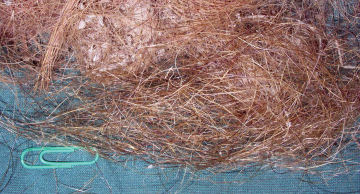Unexpected Archive: Mammoth hair yields ancient DNA
Analysis of hair from several ancient mammoths suggests that even tiny samples that are tens of thousands of years old can contain enough genetic material to allow reconstruction of portions of the animal’s genome. The new findings hint that museum collections could be untapped troves of genetic treasure.

The largest part of a creature’s genome appears in a cell’s nucleus and includes DNA from both parents. A smaller amount of genetic material appears in mitochondria, the energy factories of the cells, which are passed down only from the animal’s mother, says Stephan C. Schuster, a genomicist at Pennsylvania State University in University Park. A cell typically has only one nucleus, but it can have a thousand or more mitochondria.
Scientists have compiled only a handful of mitochondrial genomes of ancient creatures, says Schuster. And those analyses scrutinized genetic material extracted only from bones. Although they persist in the environment longer than soft tissues do, bones are porous and prone to bacterial contamination. In fact, more than 50 percent of the DNA collected during one study of mammoth-bone material came from bacteria and other sources.
Recently, Schuster and his colleagues looked for mammoth DNA within shafts of the ancient creatures’ hair. As cells in each hair follicle die and are forced outward, fragments of their DNA are locked within.
Mammoth hair is commonly preserved in the cold, arid conditions where the creatures lived, says Schuster. Moreover, he notes, any bacterial or fungal contamination on the hair can be removed with a little bleach.
Most of the mammoth hair that the researchers examined contained abundant mitochondrial DNA. Even the smallest sample, about 0.2 gram, yielded enough genetic material to reconstruct at least seven copies of the mitochondrial genome, says Tom Gilbert, a geneticist at the University of Copenhagen and a coauthor of the report in the Sept. 28 Science. In future research, the scientists intend to reconstruct the mammoth’s nuclear genome.
“This is a very nice study and a clever use of hair as a DNA source to get around the problem of contaminating bacteria, fungi, and other microorganisms,” says Alan Cooper, a paleogeneticist at the University of Adelaide in Australia.
Results of the team’s analyses suggest that the genetic material was preserved because keratin, the material of which hair is made, repels water, a major source of DNA degradation. Many other biological materials, including horns, hooves, feathers, and the sheaths on claws, are made of keratin.
The smallest sample that the team analyzed was also one of the oldest, says Schuster. It came from a 41,000-year-old mammoth that was recovered in 1806 and whose hair had been stored since then at room temperature in a Russian museum.
The new findings could spawn a stampede to collect genetic information from the multitude of specimens collected decades ago during field trips and that are now gathering dust in museums. Schuster says that the new activity could be called “museomics.” The technique could be especially useful for species whose preserved bones are rare, if not absent, but whose keratinous tissues are common.
“The information is already sitting there” in specimen collections, he notes. “The hard part of the work is done.”







